
Masks
We go diving to see the underwater world. We want to gaze at a whale shark cruising above our heads, we want to ogle as a manta ray glides below our feet and the chance to glimpse a sea turtle is a big excitement for any diver. What links all these statements is our sight, when we go diving we want our vision to be as close to that of the surface as possible so we can watch the animals of the deep do what they do best; amaze us.
Obviously our sight is poor underwater because our eyes are not adapted to directly interpret light in liquid. Thus, we require a thin layer of air around our eyes to allow them to focus and to maximise comfort (I find salt water on my eyeballs very unpleasant). So, we wear masks to protect our eyes from the water and to give us the best possible view of our aquatic wonderland (or just your dive computer if the visibility is bad…).
The following is a guide to the basics of choosing, using and caring for a mask – your peephole into the sea.
Shapes – Masks come in a huge range of shapes and sizes and each have their own advantages and drawbacks. Some styles are almost extinct whereas other designs are becoming chic SCUBA fashion.
- Single/Double Lens – Older masks had only one large square glass view box which offered limited view range. The single lenses of today are stretched downwards (towards the cheeks) and wide (towards the ear), this gives them a very large sight angle. They can be prone to breakages because of their large plate of unsupported glass. The double lens mask aims to overcome this by splitting the lens into two large view goggles. This gives the lens more support making it more resilient to stray gear banging against it in a kit bag. This extra durability comes at the cost of a (slightly) narrowed viewing angle.
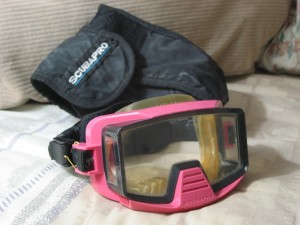
- Old Single Lens Mask
- Wraparound – A wraparound mask is one where a single lens has been manufactured with side windows to widen the divers view considerably. This gives the diver a three dimensional space to peer into the abyss from – a real advantage when working with students or novice buddies as you can easily ensure they are still with you by glancing out the corner of your eye. They often have a shorter vertical viewing angle – which means it could be harder to see your gauges.
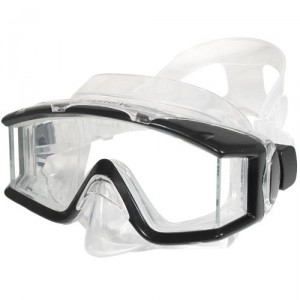
- Wraparound – Scubapro Crystel Vu
- Frameless – This is a fairly new mask design trend which entails the removal of the large bulky frame that holds the lens in place in traditional masks and uses the lens itself as the structural body with the skirt being glued directly onto the lens. This makes for an even larger view range, lighter mask and better storage flexibility but sacrifices durability as the lens is a large target to break and is unsupported.
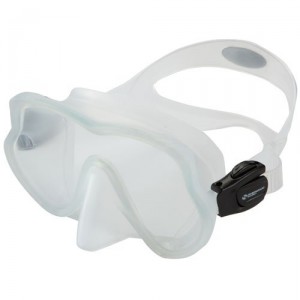
- Frameless – Sherwood Scuba Rona
- Low Profile – Most modern mask designers strive to make the mask’s profile as low as they can, this means that the mask has as little air space inside it as possible. This makes it easier to clear because less air is needed to force the water out. They usually achieve this by bringing the lens as close to the wearer’s face as possible.
Materials – Masks are heavy use items that arguably affect the quality of a dive more so than any other item of equipment, therefore modern mask manufacturers use a range of different materials to achieve light, comfortable and durable pieces of gear.
- Plastic – When used in making mask skirts (the part that touches your face) this material tends to be inflexible which is detrimental to its comfort and effectiveness. All but extinct, only used in the cheapest masks.
- Silicone – Modern masks are almost exclusively made with this material as it is durable, stretchy, soft, cheap and fairly neutral to skin. Silicone is used to make the skirts and straps on most masks. The quality of the silicone can be tested by simply comparing the softness of the skirts. If it is very soft it will mould to the contours of your face better and feel more comfortable (though it may be less tear resistant).
- Glass – Almost all masks use glass for the viewing window because it provides greater clarity than plastics while still remaining very strong. The lens is tempered glass to resist shattering and will take a great deal of punishment. Prescription lenses are also available and are made from glass.
Straps – A mask must be watertight, even during fast swimming and in heavy currents which means that it must be held onto your head with some force, while remaining comfortable and being adjustable for the huge variation in diver’s head sizes.
- Silicone – Most mask straps use a silicone strap that splits into two at the back (at the crown of your head) to spread the load and keep it stable. The straps are usually adjusted by a notch and ratchet system that allows the diver to loosen the strap, hold the mask in place and then pull the straps tight. The ratchet will keep the straps at this tightness. The system is well known but not particularly suited to delicate adjustments, nor threading the strap into the ratchet after removing the strap (which might be necessary to affix a snorkel to the mask).
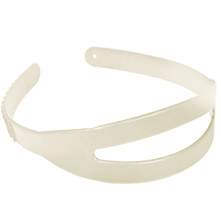
- Silicone Mask Strap
- Covers – Divers like to modify their gear. They want to know what gear is theirs in a busy boat, they want to be instantly identifiable under the water and they want to be at least semi-individual. There are approximately a billion mask strap covers available on the market today to help serve this need. The covers are simple neoprene sleeves that fit over the silicone strap to make it more comfortable by padding the thin straps and by reducing the amount that a mask strap pulls your hair. They also come with every bad diver joke ever told scrawled across them – each to their own I guess…
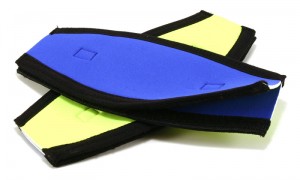
- Neoprene Mask Covers
- Velcro™ – To take the idea of modifying your mask further I’d recommend using a Velcro™ mask strap. It fits into most mask ratchets but doesn’t use the ratchet to hold the strap in place, instead it uses Velcro™ to secure the strap. This means that once the diver has found the right size (which is easy – you can be millimetre perfect) the strap never needs adjusted. At the crown there is a neoprene patch like the strap covers that allows the strap to stretch and fit comfortably. This is my personal choice.
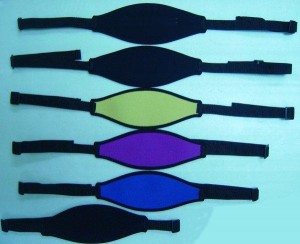
- Velcro Mask Strap
Fit – Now that you know which mask you want, you need to try it on, because if it doesn’t fit perfectly then it’s not the mask for you. Fit is key to choosing a mask.
- Fitting – To fit a mask you must first move the strap the front of the lens and brush your hair from your face. Next, hold the mask against your face and gently, and for a prolonged period, inhale through your nose. The mask should suction to your face closely and with no apparent air gaps. Follow this with a test of the mask’s comfort by putting it on properly with the strap in place, adjust if necessary. Feel the weight of the mask, move your head around and test your range of vision. Try looking at your waist, where your gages will likely live or over your shoulder at imaginary divers. If there are any pinch points, especially on the bridge of your nose then this mask is not for you.
- Troubleshooting – A mask can cause a range of problems for the novice user:
- One perennial problem is a diver getting a sore point on the bridge of his nose, this is often caused by a double lensed mask that has a too small nose pocket, the solution to this is to use a larger, single lens mask.
- Hair is the enemy of a perfect seal around your face. Always remember to brush any head hair out from your forehead. If you have long hair then you will likely tie your hair back anyway but pay particular attention to your fringe to avoid unnecessary leaking.
- A less easy hair problem to solve is for those gents that dive unshaven – a beard or moustache will let in an uncomfortable amount of water unless properly treated. The simple solution is to shave off the whiskers but this is not to everyone’s taste (divers are a vain lot) so the best tip is to use some Vaseline™ or wax to help make a seal around your facial hair (not ideal, but better than diving blind).
Care – Once you’ve tested all the masks in the shop (this isn’t an exaggeration – really try every mask) and found your dream visor you will want to keep it in good, working condition. Masks are simple to look after but easily forgotten in a gear cleanup.
- Defogging – A mask must offer clear viewing (even if the sea doesn’t) so a fogged lens is as much use as a soluble dive computer. Divers have a hundred ways of fixing this problem but tried and tested works best for me. I toothpaste the inside of the mask lens when I fist get it to remove the manufacturing film. Just apply and smear standard toothpaste all over the lens and then, after a few hours, rinse it off (pick a toothpaste that smells nice – you will smell it for the first couple of dives!). Once the lens is prepared you have two options – either use a defogging spray which are very effective but are a little pricey, or use good old-fashioned human saliva. Spit onto the lens before the dive, rub it around and don’t wash it off. The saliva resists the fogging.
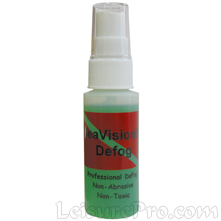
- Mask Defog Spray
- Cleaning – Always rinse your mask after use, even in the pool or freshwater. Once in a while you should give your mask a good soak in warm, soapy water and give it a light scrub. Never use any abrasive cleaners, or boiling water. A disinfectant is a good choice for getting rid of tropical mould – use a medical disinfectant if possible.
- Storage – Once you’ve cleaned your mask you should store it somewhere dry, room temperature, out of direct sunlight and away from heavy objects that might bang it. Consider using the box it came in (most are designed to be used as a case) for protection and possibly put some silica gel packets in with it to keep it dry. Try to keep the mask’s shape while storing to prevent deforming.